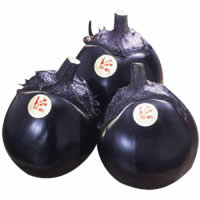京都府の農業

京のブランド産品
賀茂なす Kamo-Nasu Eggplant 賀茂茄子

「一富士、二鷹、三茄子」といわれるように、茄子は昔から縁起の良いものとされてきました。それは、ナスは成すと同音で、物事を成し遂げるという願いにつながると考えられたからとか。京都の賀茂なすは、江戸時代、「ナスには紫茄、黄茄、白茄色々あるが紫茄が良い。形は又、細長い長茄などあるが、風味円大な洛東河原(現在の左京区吉田、田中辺り)のものが最高で ある」と書物に記されています。その種が上賀茂の人たちによって、大切に育てられたのが現在の賀茂なす。なすの女王ともいえる風格と味わいを持つ京の逸品です。ガクの下が真っ白で、ずっしりと重いことも京の賀茂なすの特徴です。
As the saying goes “First – Fuji, second – hawks, third – eggplants”, eggplants have been referred to as a sign of good luck for a long time. Because the words “eggplant” and “to achieve” are homonyms in Japanese, people believed that it can lead you to accomplish your desires. In the Edo era, it was said about the Kamo-nasu that “eggplants come in different colors – purple, yellow, and white, but the the purple colored ones are great. There are also different shapes, such as long and thin eggplants, but the flavor of big round eggplants from Rakuto Kawara (present Sakyo Ward, Yoshida, around Tanaka) as the best”, according to the description found in the books. The present Kamo eggplant type is carefully nurtured by the people of Kamogamo. It is a masterpiece of Kyoto and is said to be the queen of eggplants. Kamo eggplants are characterized by its white color under the calyx (the outermost group of floral parts) and its heavy weight.
如同「一富士、二鷹、三茄子」所說的一樣,茄子自古以來就是被當作吉祥之物。那是因為茄子的日文作「なす」(Nasu)與有事盡成之意的「成す」(Nasu)同音。關於京都的賀茂茄子,於江戶點代書中是這樣記載的,「茄子當中有紫茄、黄茄、白茄等各式各樣的品種,當中屬紫茄最優。形狀上也有細長的長茄等外觀,但還是屬豐饒的洛東河原(現在的左京區吉田、田中附近)所產的品種最棒。」。正因為受到上賀茂的人們細心地照顧培育,因此才有了現在的賀茂茄子。如茄中女王般的賀茂茄子,可說是別具風味的京之逸品。萼下部分呈現純白色,外觀圓潤沉甸也是京都賀茂茄子的特徵喔。
